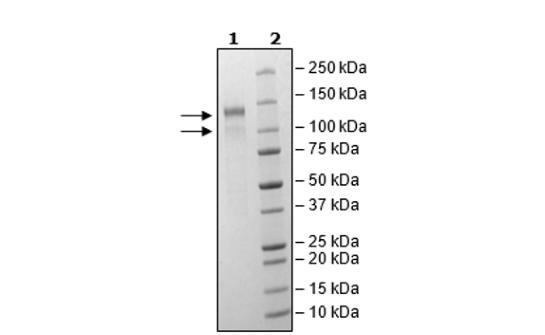LDLR, FLAG-Avi-Tag, Biotin-Labeled Recombinant
Only %1 left
Catalog #
71206
As low as
$330
*
●
●
Purchase
Description
Recombinant human LDLR (Low Density Lipoprotein Receptor), encompassing amino acids 22-788. This construct contains a C-terminal FLAG-tag followed by an Avi-Tag™. The recombinant protein was enzymatically biotinylated using the Avi-Tag™ and affinity purified.
●
Synonyms
FH, FHC, LDLR, LDLCQ2, low density lipoprotein receptor
●
Product Data Gallery
Product Info
Storage and Usage
Citations
Species
Human
Construct
LDLR (22-788(end)-FLAG-Avi)-(Biotin)
Host Species/Expression System
HEK293
Purity
≥90%
Format
Aqueous buffer solution
Formulation
8 mM phosphate, pH 7.4, 110 mM NaCl, 2.2 mM KCl, and 20% glycerol
MW
88 kDa + glycans
Amino Acids
22–788(end)
Glycosylation
This protein runs at a higher MW by SDS-PAGE due to glycosylation.
Genbank #
NM_000527
UniProt #
P01130
Label
This protein is enzymatically biotinylated using Avi-Tag™ technology. Biotinylation is confirmed to be >90%.
For more information on enzymatic biotinylation, please see our Tech Note.
Background
The low density lipoprotein receptor (LDLR) gene family consists of cell surface proteins involved in receptor-mediated endocytosis of specific ligands. Low density lipoprotein (LDL) is normally bound at the cell membrane and taken into the cell ending up in lysosomes where the protein is degraded and the cholesterol is made available for repression of microsomal enzyme 3-hydroxy-3-methylglutaryl coenzyme A (HMG CoA) reductase, the rate-limiting step in cholesterol synthesis. At the same time, a reciprocal stimulation of cholesterol ester synthesis takes place. Mutations in this gene cause the autosomal dominant disorder, familial hypercholesterolemia. In case of HIV-1 infection, it functions as a receptor for extracellular Tat in neurons, mediating its internalization in uninfected cells. PCSK9 binds to the epidermal growth factor-like repeat A (EGF-A) domain of LDLR, inducing LDLR degradation.




